NMR-Based Metabolomic Analysis for the Effects of α-Ketoglutarate Supplementation on C2C12 Myoblasts in Different Energy States
Abstract
1. Introduction
2. Results
2.1. Proliferation and Differentiation of C2C12 Myoblasts with AKG Supplementation
2.2. NMR Spectra of Aqueous Extracts of C2C12 Myoblasts
2.3. Multivariate Data Analysis for Exploring Cellular Metabolic Profiles
2.4. Identifications of Differential and Important Metabolites
2.5. Identification of Significantly Altered Metabolic Pathways
2.6. Antioxidant Capacities of C2C12 Myoblasts with AKG Supplementation
2.7. Energy States of C2C12 Myoblasts with AKG Supplementation
3. Discussion
3.1. AKG Promotes Proliferation and Differentiation of Myoblasts
3.2. AKG Improves Glutamate and Glutamine Metabolism
3.3. AKG Promotes Antioxidant Capacity of Myoblasts under Low-Glucose Culture Condition
3.4. AKG Enhances Cellular Energy Status
4. Materials and Methods
4.1. Cell Culture
4.2. MTS Cell Proliferation Assay and Morphologies of Myoblasts and Myotubes
4.3. Western Blotting
4.4. Intracellular Metabolite Extraction and Samples Preparation
4.5. NMR Measurements and Data Preprocessing
4.6. Resonance Assignments of Metabolites
4.7. Metabolomic Analysis
4.8. Measurement of Cellular Total Antioxidant Capacity (T-AOC)
4.9. Measurement of Intracellular ATP Content
5. Conclusions
Supplementary Materials
Author Contributions
Funding
Institutional Review Board Statement
Informed Consent Statement
Data Availability Statement
Conflicts of Interest
Sample Availability
References
- Kerksick, C.M.; Wilborn, C.D.; Roberts, M.D.; Smith-Ryan, A.E.; Kleiner, S.M.; Jäger, R.; Collins, R.; Cooke, M.; Davis, J.N.; Galvan, E.; et al. ISSN exercise & sports nutrition review update: Research & recommendations. J. Int. Soc. Sports Nutr. 2018, 15, 38. [Google Scholar] [CrossRef] [PubMed]
- Blomqvist, B.I.; Hammarqvist, F.; Von Der Decken, A.; Wernerman, J. Glutamine and α-ketoglutarate prevent the decrease in muscle free glutamine concentration and influence protein synthesis after total hip replacement. Metabolism 1995, 44, 1215–1222. [Google Scholar] [CrossRef]
- Coudray-Lucas, C.; Le Bever, H.; Cynober, L.; De Bandt, J.-P.; Carsin, H. Ornithine α-ketoglutarate improves wound healing in severe burn patients: A prospective randomized double-blind trial versus isonitrogenous controls. Crit. Care Med. 2000, 28, 1772–1776. [Google Scholar] [CrossRef] [PubMed]
- Li, S.; Fu, C.; Zhao, Y.; He, J. Intervention with α-ketoglutarate ameliorates colitis-related colorectal carcinoma via modulation of the gut microbiome. BioMed Res. Int. 2019, 2019, 1–9. [Google Scholar] [CrossRef]
- Zhao, J.; Jiang, Y.; Sun, X.; Liu, X.; Liu, F.; Song, M.; Zhang, L. The mechanism and role of intracellular α-ketoglutarate reduction in hepatic stellate cell activation. Biosci. Rep. 2020, 40, 40. [Google Scholar] [CrossRef]
- Chen, J.; Wu, F.; Yang, H.; Li, F.; Jiang, Q.; Liu, S.; Kang, B.; Li, S.; Adebowale, T.; Huang, N.; et al. Growth performance, nitrogen balance, and metabolism of calcium and phosphorus in growing pigs fed diets supplemented with alpha-ketoglutarate. Anim. Feed. Sci. Technol. 2017, 226, 21–28. [Google Scholar] [CrossRef]
- Shahmirzadi, A.A.; Edgar, D.; Liao, C.-Y.; Hsu, Y.-M.; Lucanic, M.; Shahmirzadi, A.A.; Wiley, C.D.; Gan, G.; Kim, D.E.; Kasler, H.G.; et al. Alpha-ketoglutarate, an endogenous metabolite, extends lifespan and compresses morbidity in aging mice. Cell Metab. 2020, 32, 447–456.e6. [Google Scholar] [CrossRef]
- Hou, Y.Q.; Wang, L.; Ding, B.Y.; Liu, Y.L.; Zhu, H.L.; Liu, J.; Li, Y.T.; Kang, P.; Yin, Y.L.; Wu, G.Y. Alpha-ketoglutarate and intestinal function. Front. Biosci-Landmrk 2011, 16, 1186–1196. [Google Scholar] [CrossRef]
- He, L.; Li, H.; Huang, N.; Zhou, X.H.; Tian, J.Q.; Li, T.J.; Wu, J.; Tian, Y.N.; Yin, Y.L.; Yao, K. Alpha-ketoglutarate suppresses the NF-kappa B-mediated inflammatory pathway and enhances the PXR-regulated detoxification pathway. Oncotarget 2017, 8, 102974–102988. [Google Scholar] [CrossRef]
- Cai, X.C.; Zhu, C.J.; Xu, Y.Q.; Jing, Y.Y.; Yuan, Y.X.; Wang, L.N.; Wang, S.B.; Zhu, X.T.; Gao, P.; Zhang, Y.L.; et al. Alpha-ketoglutarate promotes skeletal muscle hypertrophy and protein synthesis through Akt/mTOR signaling pathways. Sci. Rep. 2016, 6, 26802. [Google Scholar] [CrossRef]
- Chen, J.; Su, W.; Kang, B.; Jiang, Q.; Zhao, Y.; Fu, C.; Yao, K. Supplementation with α-ketoglutarate to a low-protein diet enhances amino acid synthesis in tissues and improves protein metabolism in the skeletal muscle of growing pigs. Amino Acids 2018, 50, 1525–1537. [Google Scholar] [CrossRef]
- Cai, X.; Yuan, Y.; Liao, Z.; Xing, K.; Zhu, C.; Xu, Y.; Yu, L.; Wang, L.; Wang, S.; Zhu, X.; et al. α-Ketoglutarate prevents skeletal muscle protein degradation and muscle atrophy through PHD3/ADRB2 pathway. FASEB J. 2018, 32, 488–499. [Google Scholar] [CrossRef] [PubMed]
- Cui, P.; Huang, C.; Guo, J.; Wang, Q.; Liu, Z.; Zhuo, H.; Lin, D. Metabolic Profiling of Tumors, Sera, and Skeletal Muscles from an Orthotopic Murine Model of Gastric Cancer Associated-Cachexia. J. Proteome Res. 2019, 18, 1880–1892. [Google Scholar] [CrossRef] [PubMed]
- He, W.; Miao, F.J.-P.; Lin, D.C.-H.; Schwandner, R.T.; Wang, Z.; Gao, J.; Chen, J.-L.; Tian, H.; Ling, L. Citric acid cycle intermediates as ligands for orphan G-protein-coupled receptors. Nature 2004, 429, 188–193. [Google Scholar] [CrossRef]
- Wang, Q.; Zhang, Q.; Zhang, Y.; Zhao, X. Yak OXGR1 promotes fibroblast proliferation via the PI3K/AKT pathways. J. Cell. Biochem. 2019, 120, 6729–6740. [Google Scholar] [CrossRef] [PubMed]
- Tischler, J.; Gruhn, W.H.; Reid, J.; Allgeyer, E.; Buettner, F.; Marr, C.; Theis, F.; Simons, B.D.; Wernisch, L.; Surani, M.A. Metabolic regulation of pluripotency and germ cell fate through α-ketoglutarate. EMBO J. 2019, 38. [Google Scholar] [CrossRef] [PubMed]
- Yuan, Y.; Xu, P.; Jiang, Q.; Cai, X.; Wang, T.; Peng, W.; Sun, J.; Zhu, C.; Zhang, C.; Yue, D.; et al. Exercise-induced α-ketoglutaric acid stimulates muscle hypertrophy and fat loss through OXGR1-dependent adrenal activation. EMBO J. 2020, 39, e103304. [Google Scholar] [CrossRef]
- Nicholson, J.K.; Lindon, J.C.; Holmes, E. ’Metabonomics’: Understanding the metabolic responses of living systems to pathophysiological stimuli via multivariate statistical analysis of biological NMR spectroscopic data. Xenobiotica 1999, 29, 1181–1189. [Google Scholar] [CrossRef] [PubMed]
- Bollard, M.E.; Stanley, E.G.; Lindon, J.C.; Nicholson, J.K.; Holmes, E. NMR-based metabonomic approaches for evaluating physiological influences on biofluid composition. NMR Biomed. 2005, 18, 143–162. [Google Scholar] [CrossRef] [PubMed]
- Xu, W.; Huang, C.; Lin, N. NMR-based metabolomic analysis for the effects of creatine supplementation on mouse myoblast cell line C2C12. Acta Biochim. Biophys. Sin. 2017, 49, 617–627. [Google Scholar] [CrossRef] [PubMed]
- Liu, Z.; Huang, C.; Liu, Y.; Lin, N.; Zhao, Y. NMR-based metabolomic analysis of the effects of alanyl-glutamine supplementation on C2C12 myoblasts injured by energy deprivation. RSC Adv. 2018, 8, 16114–16125. [Google Scholar] [CrossRef]
- Lepper, C.; Partridge, T.A.; Fan, C.-M. An absolute requirement for Pax7-positive satellite cells in acute injury-induced skeletal muscle regeneration. Development 2011, 138, 3639–3646. [Google Scholar] [CrossRef] [PubMed]
- Fukuda, S.; Kaneshige, A.; Kaji, T.; Noguchi, Y.-T.; Takemoto, Y.; Zhang, L.; Tsujikawa, K.; Kokubo, H.; Uezumi, A.; Maehara, K.; et al. Sustained expression of HeyL is critical for the proliferation of muscle stem cells in overloaded muscle. eLife 2019, 8, 8. [Google Scholar] [CrossRef]
- Fukada, S.-I.; Akimoto, T.; Sotiropoulos, A. Role of damage and management in muscle hypertrophy: Different behaviors of muscle stem cells in regeneration and hypertrophy. Biochim. Biophys. Acta Mol. Cell Res. 2020, 1867, 118742. [Google Scholar] [CrossRef]
- Chargé, S.B.P.; Rudnicki, M.A. Cellular and molecular regulation of muscle regeneration. Physiol. Rev. 2004, 84, 209–238. [Google Scholar] [CrossRef] [PubMed]
- Zammit, P.S.; Golding, J.P.; Nagata, Y.; Hudon, V.; Partridge, T.A.; Beauchamp, J.R. Muscle satellite cells adopt divergent fates: A mechanism for self-renewal? J. Cell Biol. 2004, 166, 347–357. [Google Scholar] [CrossRef] [PubMed]
- Tapscott, S.J. The circuitry of a master switch: Myod and the regulation of skeletal muscle gene transcription. Development 2005, 132, 2685–2695. [Google Scholar] [CrossRef] [PubMed]
- Aussel, C.; Coudray-Lucas, C.; Lasnier, E.; Cynober, L.; Ekindjian, O.G. α-ketoglutarate uptake in human fibroblasts. Cell Biol. Int. 1996, 20, 359–363. [Google Scholar] [CrossRef]
- Levitt, D.G.; Levitt, M.D. A model of blood-ammonia homeostasis based on a quantitative analysis of nitrogen metabolism in the multiple organs involved in the production, catabolism, and excretion of ammonia in humans. Clin. Exp. Gastroenterol. 2018, 11, 193–215. [Google Scholar] [CrossRef]
- Tang, X.; Fu, Y.; Zhao, Y.; Pi, J.; Wang, H. Dietary α-ketoglutarate supplementation alleviates harmful effects of high environmental ammonia on grass carp, Ctenopharyngodon idella. Aquac. Res. 2019, 51, 1182–1189. [Google Scholar] [CrossRef]
- Curi, R.; Newsholme, P.; Procopio, J.; Lagranha, C.; Gorjao, R.; Pithon-Curi, T.C. Glutamine, gene expression, and cell function. Front. Biosci-Landmrk 2007, 12, 344–357. [Google Scholar] [CrossRef]
- Yi, D.; Hou, Y.; Wang, L.; Ouyang, W.; Long, M.; Zhao, D.; Ding, B.; Liu, Y.; Wu, G. l-Glutamine enhances enterocyte growth via activation of the mTOR signaling pathway independently of AMPK. Amino Acids 2015, 47, 65–78. [Google Scholar] [CrossRef]
- Velvizhi, S.; Nagalashmi, T.; Essa, M.M.; Dakshayani, K.B.; Subramanian, P. Effects of alpha-ketoglutarate on lipid peroxidation and antioxidant status during chronic ethanol administration in Wistar rats. Pol. J. Pharmacol. 2002, 54, 231–236. [Google Scholar] [PubMed]
- Lambert, I.H.; Kristensen, D.M.; Holm, J.B.; Mortensen, O.H. Physiological role of taurine—from organism to organelle. Acta Physiol. 2015, 213, 191–212. [Google Scholar] [CrossRef]
- Das, J.; Roy, A.; Sil, P.C. Mechanism of the protective action of taurine in toxin and drug induced organ pathophysiology and diabetic complications: A review. Food Funct. 2012, 3, 1251–1264. [Google Scholar] [CrossRef]
- Liu, S.; He, L.; Yao, K. The antioxidative function of alpha-ketoglutarate and its applications. BioMed Res. Int. 2018, 2018, 1–6. [Google Scholar] [CrossRef]
- Wallimann, T.; Wyss, M.; Brdiczka, D.; Nicolay, K.; Eppenberger, H.M. Intracellular compartmentation, structure and function of creatine kinase isoenzymes in tissues with high and fluctuating energy demands: The ‘phosphocreatine circuit’ for cellular energy homeostasis. Biochem. J. 1992, 281, 21–40. [Google Scholar] [CrossRef] [PubMed]
- Elkalaf, M.; Anděl, M.; Trnka, J. low glucose but not galactose enhances oxidative mitochondrial metabolism in C2C12 myoblasts and myotubes. PLoS ONE 2013, 8, e70772. [Google Scholar] [CrossRef] [PubMed]
- Su, Y.; Wang, T.; Wu, N.; Li, D.; Fan, X.; Xu, Z.; Mishra, S.K.; Yang, M. Alpha-ketoglutarate extends Drosophila lifespan by inhibiting mTOR and activating AMPK. Aging-Us 2019, 11, 4183–4197. [Google Scholar] [CrossRef]
- Wang, L.; Yi, D.; Hou, Y.; Ding, B.; Li, K.; Li, B.; Zhu, H.; Liu, Y.; Wu, G. Dietary supplementation with α-ketoglutarate activates mTOR signaling and enhances energy status in skeletal muscle of lipopolysaccharide-challenged piglets. J. Nutr. 2016, 146, 1514–1520. [Google Scholar] [CrossRef]
- Beckonert, O.; Keun, H.C.; Ebbels, T.M.D.; Bundy, J.G.; Holmes, E.; Lindon, J.C.; Nicholson, J.K. Metabolic profiling, metabolomic and metabonomic procedures for NMR spectroscopy of urine, plasma, serum and tissue extracts. Nat. Protoc. 2007, 2, 2692–2703. [Google Scholar] [CrossRef] [PubMed]

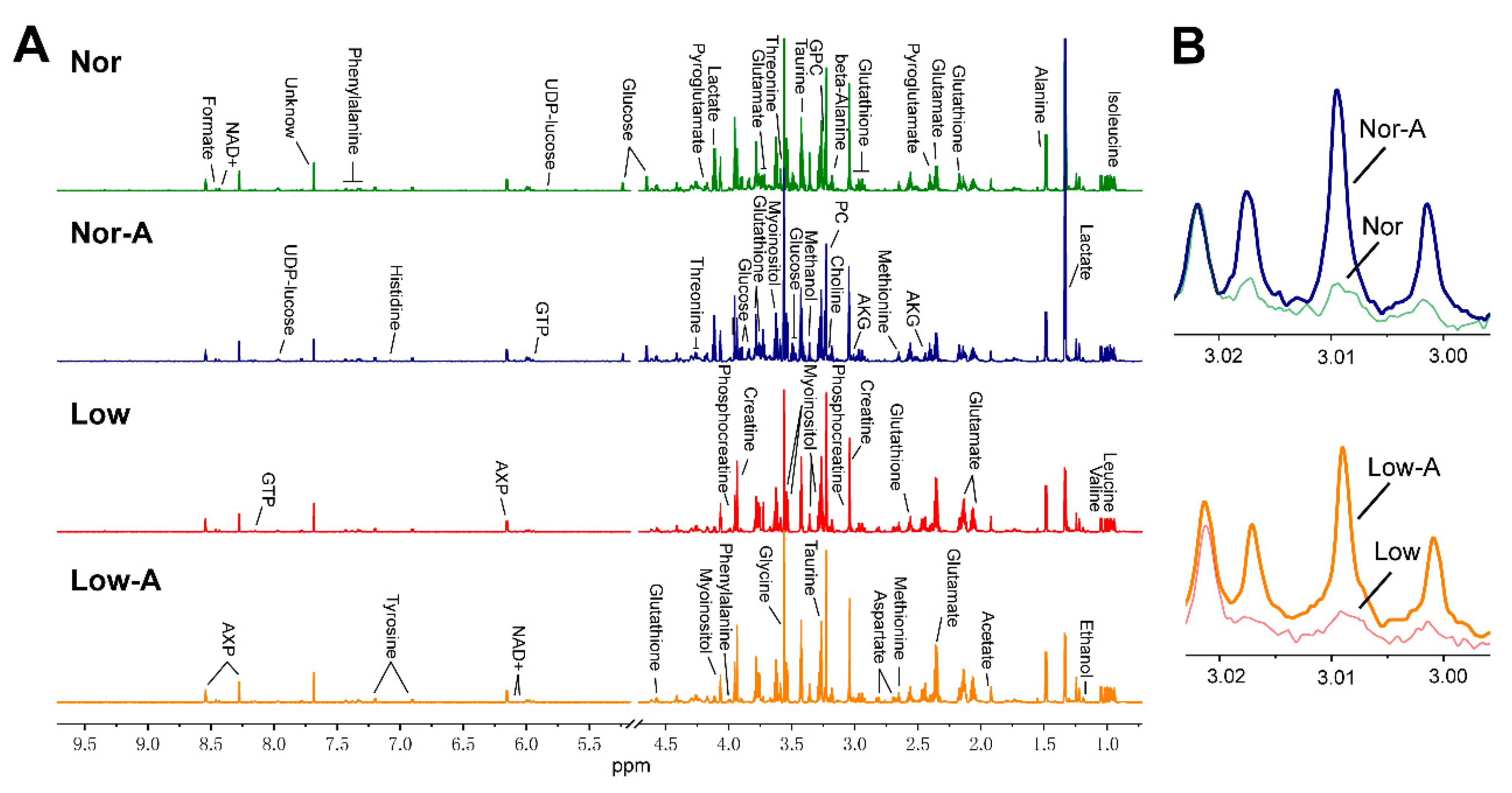
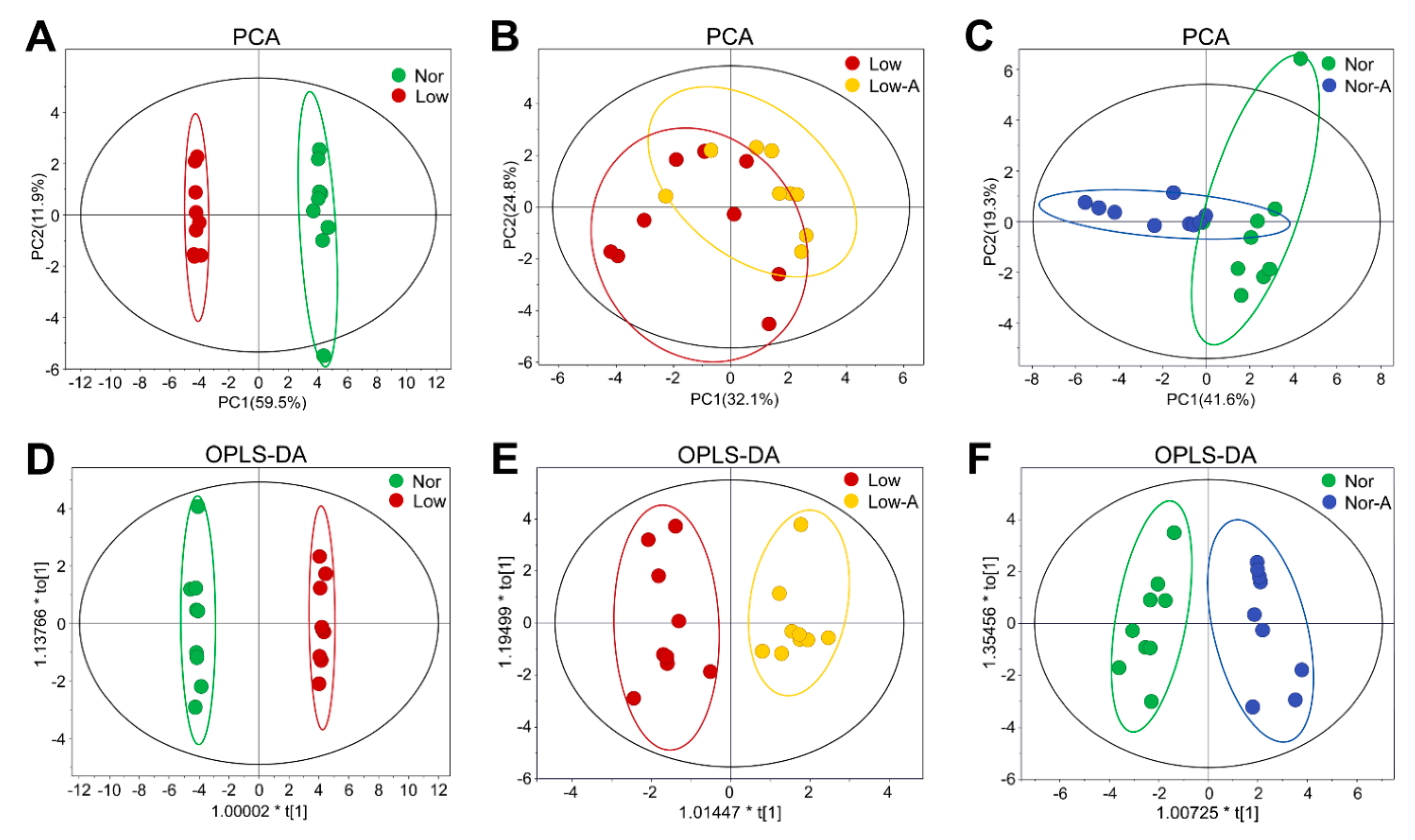

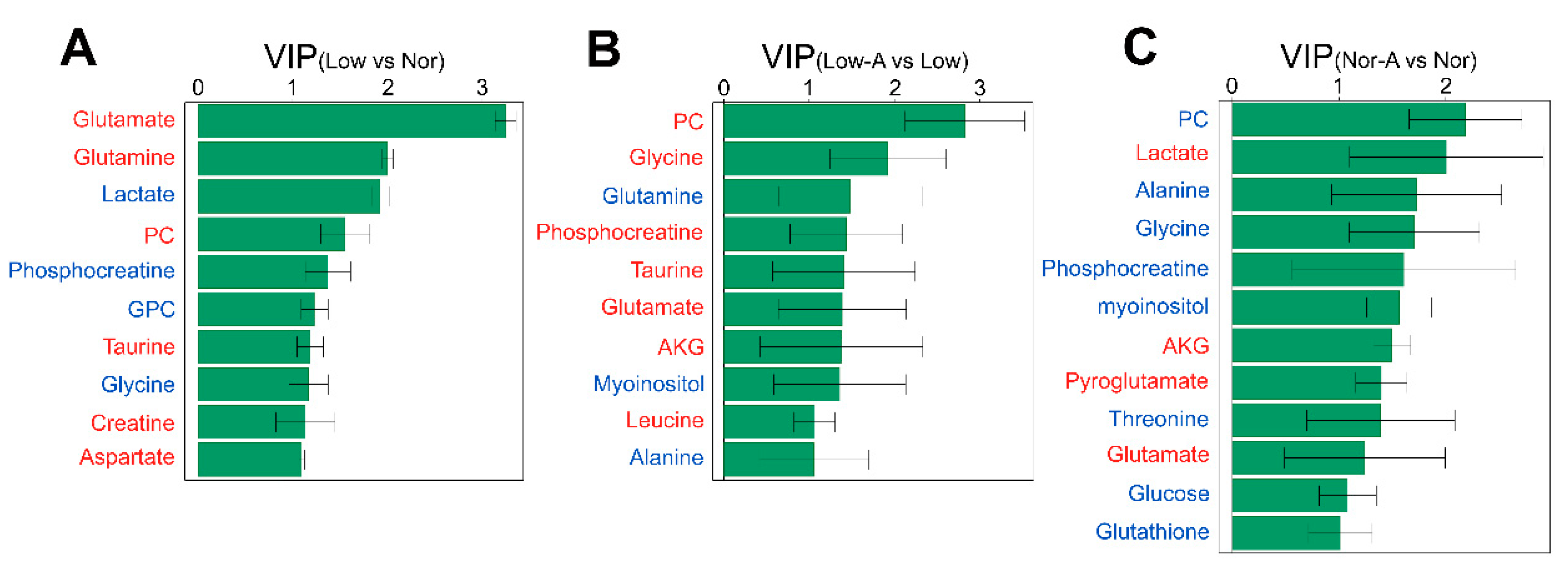
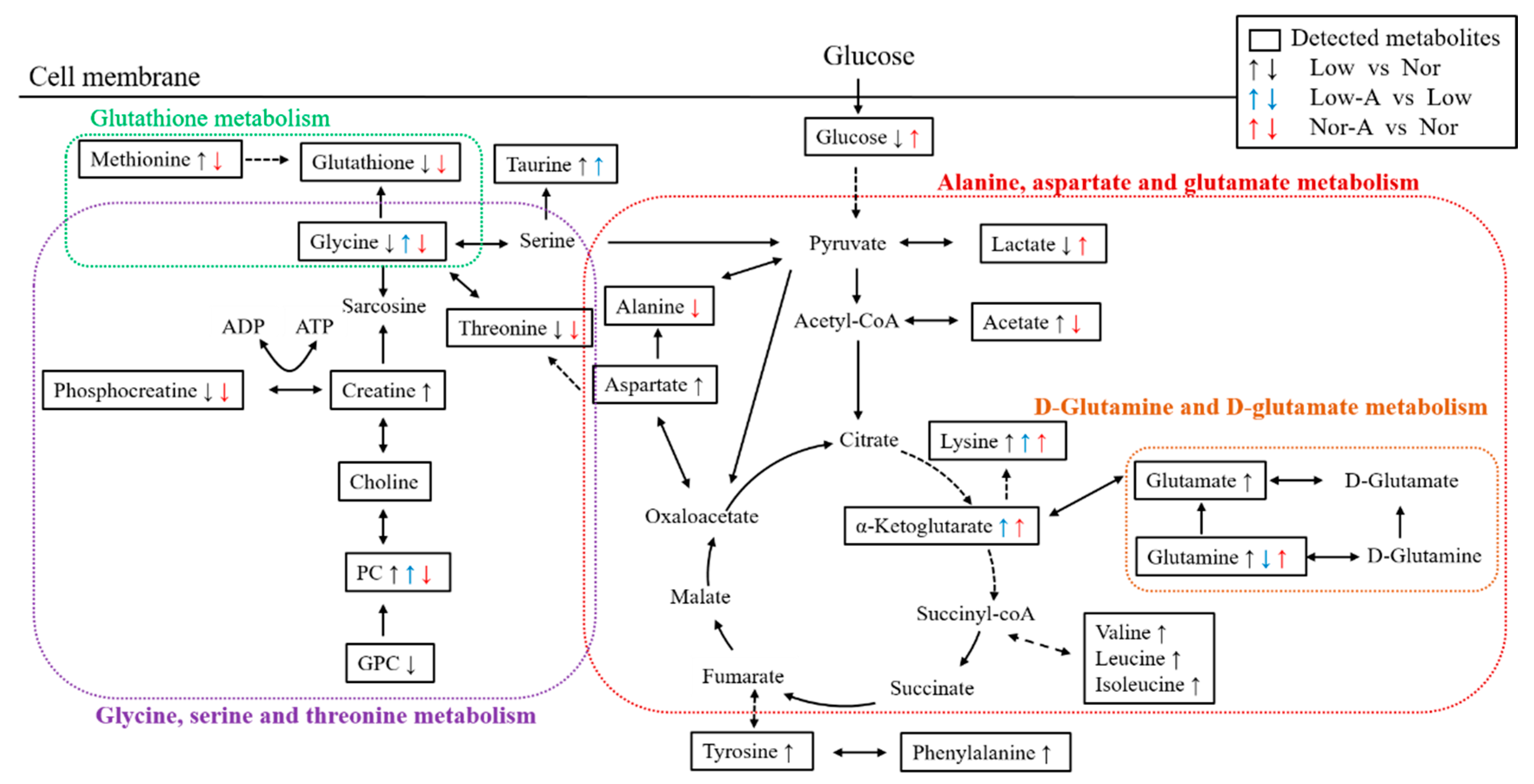
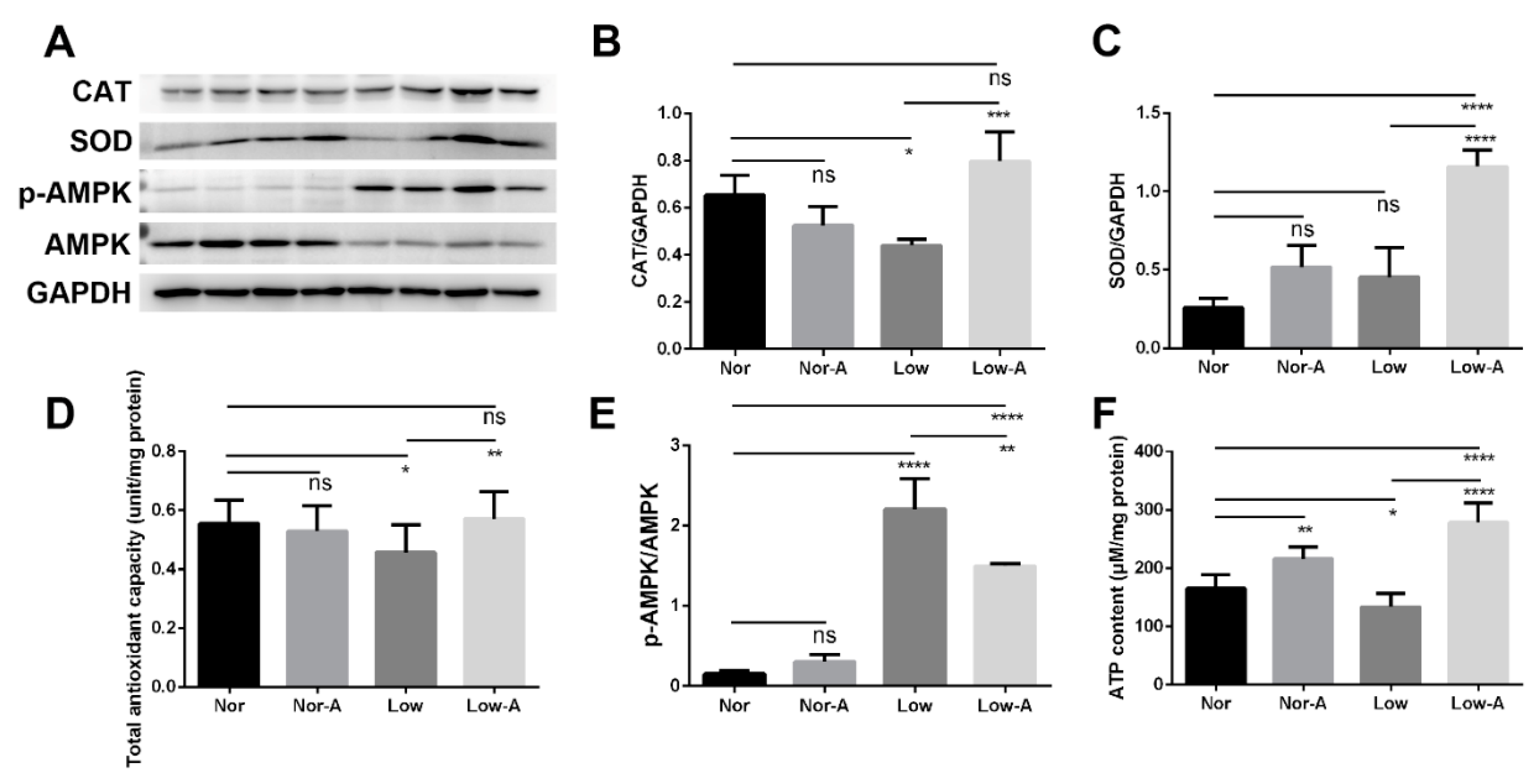
| Metabolites | Groups | ||
|---|---|---|---|
| Low vs. Nor | Low-A vs. Low | Nor-A vs. Nor | |
| Glutathione | ns | ns | ↓ |
| Glutamate | ↑ | ns | ns |
| AKG | ns | ↑ | ↑ |
| Pyroglutamate | ns | ns | ↑ |
| Glutamine | ↑ | ↓ | ns |
| Aspartate | ↑ | ns | ns |
| Creatine | ↑ | ns | ns |
| Phosphocreatine | ↓ | ns | ↓ |
| PC | ↑ | ↑ | ↓ |
| GPC | ↓ | ns | ns |
| Taurine | ↑ | ↑ | ns |
| Myoinositol | ns | ↓ | ↓ |
| Glucose | ns | ns | ↑ |
| Glycine | ↓ | ↑ | ↓ |
| Lactate | ↓ | ns | ↑ |
| Threonine | ns | ns | ↓ |
| NO | Metabolic Pathway | Low vs. Nor | Low-A vs. Low | Nor-A vs. Nor |
|---|---|---|---|---|
| 1 | Alanine, aspartate and glutamate metabolism | √ | √ | √ |
| 2 | Glycine, serine, and threonine metabolism | √ | √ | √ |
| 3 | Glutathione metabolism | √ | √ | √ |
| 4 | d-Glutamine and d-glutamate metabolism | √ | √ | √ |
| 5 | Starch and sucrose metabolism | √ | √ | |
| 6 | beta-Alanine metabolism | √ | √ | |
| 7 | Taurine and hypotaurine metabolism | √ | √ | |
| 8 | Phenylalanine metabolism | √ | ||
| 9 | Phenylalanine, tyrosine, and tryptophan biosynthesis | √ | ||
| 10 | Nicotinate and nicotinamide metabolism | √ | ||
| 11 | Histidine metabolism | √ |
Publisher’s Note: MDPI stays neutral with regard to jurisdictional claims in published maps and institutional affiliations. |
© 2021 by the authors. Licensee MDPI, Basel, Switzerland. This article is an open access article distributed under the terms and conditions of the Creative Commons Attribution (CC BY) license (http://creativecommons.org/licenses/by/4.0/).
Share and Cite
Li, Y.; Li, X.; Gao, Y.; Huang, C.; Lin, D. NMR-Based Metabolomic Analysis for the Effects of α-Ketoglutarate Supplementation on C2C12 Myoblasts in Different Energy States. Molecules 2021, 26, 1841. https://doi.org/10.3390/molecules26071841
Li Y, Li X, Gao Y, Huang C, Lin D. NMR-Based Metabolomic Analysis for the Effects of α-Ketoglutarate Supplementation on C2C12 Myoblasts in Different Energy States. Molecules. 2021; 26(7):1841. https://doi.org/10.3390/molecules26071841
Chicago/Turabian StyleLi, Yantong, Xiaoyuan Li, Yifeng Gao, Caihua Huang, and Donghai Lin. 2021. "NMR-Based Metabolomic Analysis for the Effects of α-Ketoglutarate Supplementation on C2C12 Myoblasts in Different Energy States" Molecules 26, no. 7: 1841. https://doi.org/10.3390/molecules26071841
APA StyleLi, Y., Li, X., Gao, Y., Huang, C., & Lin, D. (2021). NMR-Based Metabolomic Analysis for the Effects of α-Ketoglutarate Supplementation on C2C12 Myoblasts in Different Energy States. Molecules, 26(7), 1841. https://doi.org/10.3390/molecules26071841






